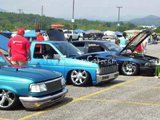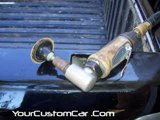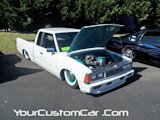Tips and Techniques To Check Your Engine Condition
Don't get stranded with a bad engine!
Check that engine condition!
Now for a deeper look into the power plant. It is important to make sure that the engine will be reliable and not leave you stranded on the side of some forgotten highway!
How well does she run?
- Any tics or chatter? If you hear a
ticking, or knocking noise upon starting the engine, this is often a
sign that the spark plugs and or ignition system should be looked at
because the engine condition might not be so great.
Faulty spark plugs or improper timing can cause what is called "spark knock" and is caused when the fuel in the cylinders is ignited too early and/or spontaneously which causes high thermal and mechanical stress, and can severely damage the engine. Spark knock should be addressed immediately in order to improve the engine condition.
A louder “metal-on-metal” sound, similar to the sound that hammering a piece of metal makes, will tell you that the engine condition is not good and has severe internal damage. This sound is often heard when a major internal piece of the motor, like a piston rod, or crankshaft, is damaged or broken. Unless you plan on rebuilding the entire engine, an engine that produces this kind of noise should be avoided at all costs.
If the engine runs well and no unusual noises are heard, there are a few things that you can check to quickly determine the general engine condition. Some of these things include:
- pull the oil dipstick out of the motor and examine
the oil shown on the dipstick. If the oil looks clean and
brown/amber, this will tell you that the oil has been recently changed
and the engine condition is in relatively good shape.
If the oil looks black or sludgy, this will tell you that the oil has not been changed in a while and needs to be drained and refilled before driving the vehicle. Lift the car and securely support it with jack stands and drain the oil.
You can hold a magnet in the stream of oil that is draining out, and then inspect the magnet for any metal particles that it grabbed out of the oil. If metal particles are present on the magnet, this will tell you that some steel part(s) inside the engine, like the piston ring(s) or crank/camshaft, are damaged.
Damage to major internal components is likely caused by lack of oil lubrication, or oil pressure, which might indicate a faulty oil pump. This will also need to be addressed ASAP.
If you can inspect the oil that has landed in your drain pan, be sure to look for traces of water/coolant. Traces of water/coolant will tell you that the head gasket(s) are likely blown.
If you see any copper glitter floating around in the oil, this will tell you that the engine bearings, such as rod bearings, or main bearings have been worn down and will need to be replaced, which is a major headache, and will require total disassembly of the engine.
Checking the oil as described above can certainly give you a good idea of how sound the engine condition and internal components of the engine are.
As for the external parts of the engine, here are a few things that you can check pretty easily to help determine the engine condition.
- Inspect the belts to see if they are
frayed, torn or even missing. Frayed or torn belts can be expected to
fail soon and will need to be replaced.
- Inspect the battery terminals (where the
battery cables attach to the battery{+/-}. If the battery terminals are
covered with corrosion, a green or white powdery substance (Poisonous Substance-do not touch with uncovered
hands!), they will need to be cleaned to ensure
that the battery cables have good contact with the battery terminals.
If the cables do not have a good connection with the battery, it will
have a hard time starting the car due to lack of power.
You can also look at the sticker on the top or the side of the battery to determine when the battery was purchased. If the battery is, lets say a 3-year battery, and the sticker says that the battery was manufactured or sold 4 years ago, then you can expect the battery will need to be replaced shortly.
- With the engine cold, the coolant level
should be checked to make sure that there is enough coolant in the
system, and also look for floating debris.
If a large amount of debris can be seen in the coolant, or if the coolant just looks dirty, the coolant system should be thoroughly flushed and refilled to help assure good engine condition. Also check the radiator/heater hoses to see if they looked dry-rotted, cracked or leaking. Poor circulating, or dirty, coolant can cause the engine to overheat and can lead to total engine failure!
- The alternator output is good to know
as well. It will be hard to measure the current without a Multimeter in
hand. However, if the car has a volt/amp meter gauge, that actually
works, either of these gauges can help you determine the output of the
alternator/charging system. An alternator that is in good shape should
provide at least 13.5 volts of current while the engine is idling.
- After the engine has reached operating temperature, and the
automatic transmission has been placed in every
gear(P, R, N, D, 2, 1-each for a few seconds), pull the transmission
dipstick out and check the level of the transmission fluid.
The level should be at the “Full-Hot” mark. If it is not at the appropriate level, transmission fluid will need to be added. Also notice how each gear engages. There should be no strange or clanking noises, and the shifts should engage smoothly for automatic and manual transmissions. Transmission repairs are very involved, thus expensive, and should only be performed by a trained transmission specialist.
- Brakes are not really engine related,
but while you are under the hood, check the brake fluid reservoir to
determine the level and cleanliness of the brake fluid. A vehicle with
poor brakes can obviously be very dangerous to drive. So, before
pulling off in the vehicle, test the brakes.
A squishy brake pedal will tell you that water or air may be present in the brake lines and you will need to flush the brake system thoroughly to get rid of the contaminated, or air ridden fluid to assure your safety.
A lot of pedal play will indicate that the brake pads are worn and will need to be replaced. Another indication of worn pad is the familiar “squealing” sound that occurs when coming to a stop.
Thanks
for viewing our Engine Condition page, please click here to return to
Build-a-Custom
YourCustomCar.com-Home











